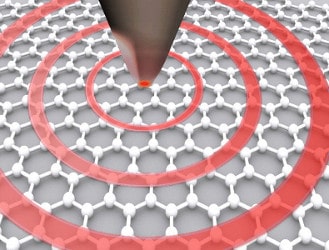neaSCOPE enables two papers on graphene plasmonics, back-to-back in Nature issue of July 5th, 2012.
Two independent research teams have successfully used their neaSCOPE infrared near-field microscopes for laying down a ghost: visualizing Dirac plasmons propagating along graphene, for the first time. They also demonstrate electric tuning of these plasmons, important for applications.
 The experiment involved launching plasmons from the neaSCOPE’s tip, having them propagate, reflect from the graphene edge, and influence the backscattering amplitude. Two unique properties of the neaSCOPE microscope were instrumental for this success:
The experiment involved launching plasmons from the neaSCOPE’s tip, having them propagate, reflect from the graphene edge, and influence the backscattering amplitude. Two unique properties of the neaSCOPE microscope were instrumental for this success:
(i) the high spatial resolution of <20nm allowed to easily resolve the plasmon standing waves which have periods as small as 100 nm, and
(ii) more subtle, the highly confined light at the tip helps to efficiently launch the plasmons, giving them the momentum “kick” needed, 50-times that of photons.
Graphene is a fascinating new material, a sheet of carbon just one atom thick, with remarkable strength and high electronic conductivity. It is considered a possible candidate for future computers. Now that electric tuning of plasmons has been demonstrated, graphene transistors could be envisaged that are driven either electrically or optically, in nanometrically small dimensions.
Prof. Frank Koppens from ICFO (Barcelona, Spain) summarizes: “Graphene is a novel and unique material for plasmonics, truly bridging the fields of nano-electronics and nano-optics”. But apart from applications, “There also is entirely new, fundamental science coming out of this”, says Prof. Dimitri Basov from UCSD (San Diego, USA). “By monitoring plasmons, we learn what electrons do in this new form of carbon, how fundamental interactions govern their properties. This is a path of inquiry.”

